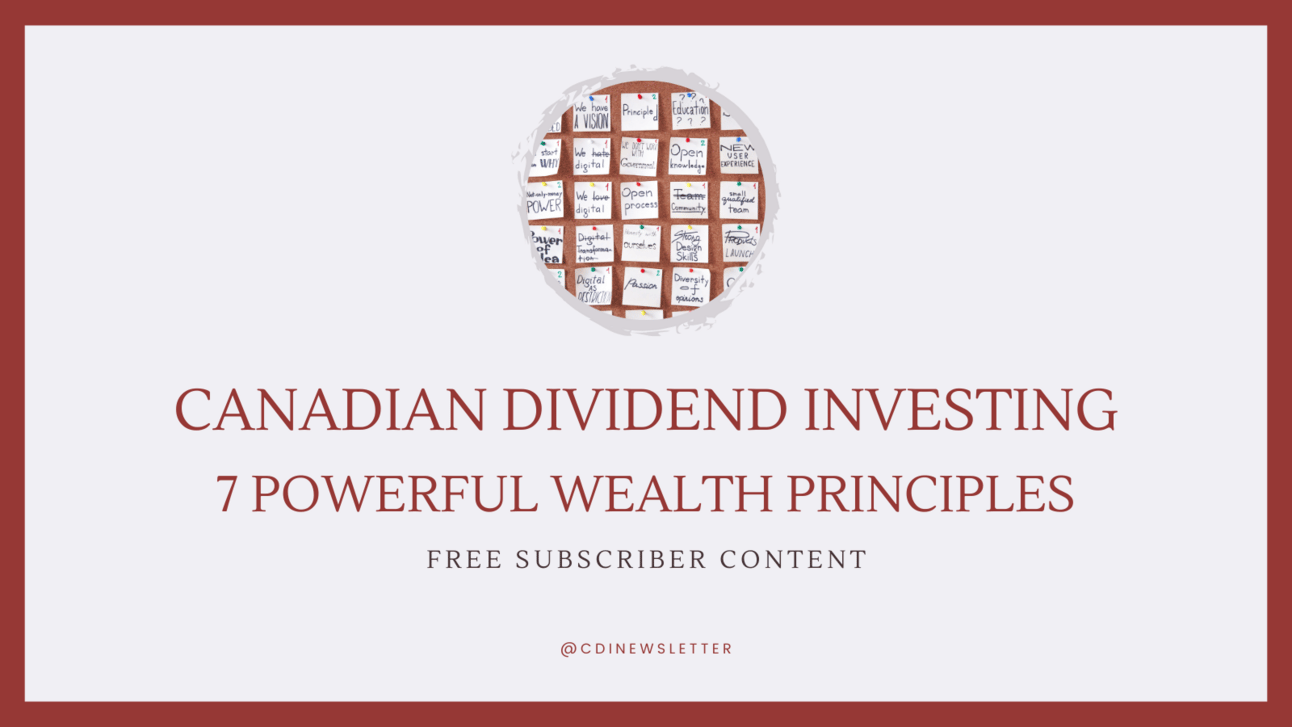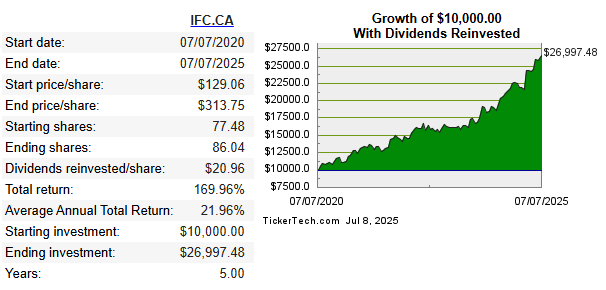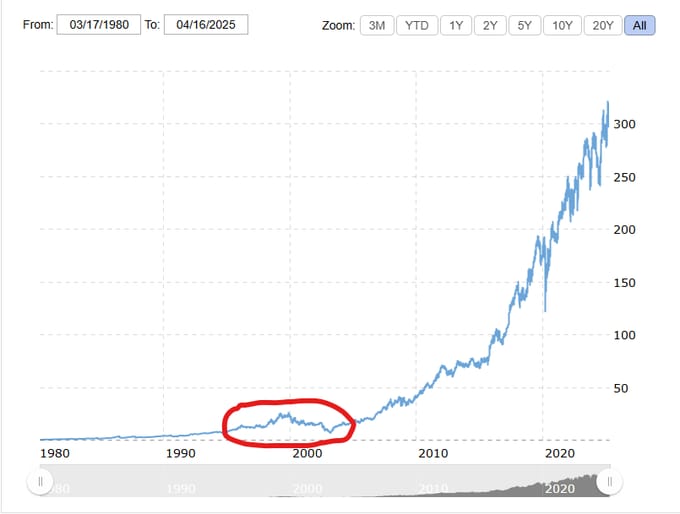- Canadian Dividend Investing
- Posts
- 7 Powerful Wealth Principles That Changed My Life
7 Powerful Wealth Principles That Changed My Life
How to get rich the boring, unsexy way
Today’s newsletter is one I’ve been meaning to write for months now, but just couldn’t find the proper words. Because how do you instill wealth into just a few important rules without sounding like every single low-effort article in the history of the internet?
It doesn’t take a genius to tell folks to spend less than they make, to buy a broad market ETF, or to max out their TFSA. These things are simple to understand for anybody willing to put in even the minimum effort.
Besides, this is an investing newsletter, one started with the assumption that the typical reader would have their personal finance life in order before graduating to learning how to invest the excess cash flow generated each month.
Even so, I think I have a fairly unique perspective on how to build wealth. I became financially independent before my 40th birthday, and I did it taking an unconventional path. I didn’t go to college. I lived in a small town. I mostly made a comfortable middle class living, but nothing more. Despite those handicaps, I succeeded beyond my wildest dreams.
What I realized when prepping for this article is becoming financially independent isn’t that hard. It comes down to a few principles and flawless execution. If you get the big things right then the details don’t really matter much. And I dominated those big things.
Without any further ado, let’s get into the meat of the potatoes. Here are the 7 keys I used to build wealth, timeless solutions that’ll work for everyone.

Create the largest savings rate possible
There’s this seemingly never-ending struggle between two camps in the world of personal finance.
The first loves frugality. They’ll gladly search online for deals, clip coupons, and figure out innovative ways to spend less on the things they’d buy anyway. These folks are conscious consumers, and I respect the hell out of them for realizing that you can have a perfectly happy life without the latest gadget.
The other group thinks frugality is a waste of time. They argue one well-timed $30,000 pay raise outperforms anything but the most extreme cheapskate. After all, there’s only so much you can cut, while the amount of money you can make is limitless. Therefore, you should spend your time on that.
And then you have me, smack dab in the middle. I think they’re both right.
Sure, you can only cut a certain amount, but that doesn’t mean you shouldn’t cut at all. Let’s face it; the average person — including your author, I’m not hardcore any longer — has a mountain of spending they could cut. I’m currently subscribed to three four streaming services. I regularly go on international vacations. I’m sitting on a $500+ office chair.
Besides, most people don’t actually have access to some career path with limitless earnings. Most professionals will peak at a certain amount. Many have limited access to overtime or just don’t have the energy for a side hustle after taking care of kids, aging parents, or other important things that aren’t well compensated.
Saying that, I also believe you owe it to yourself to be maximizing your earnings, especially in your 20s and 30s. Feel free to jump employers, they wouldn’t be loyal to you come layoff time anyway. It’s also the perfect age for a side hustle or second part-time job, since you’ll have the energy to do it.
The earn more versus spend less argument is silly. Smart people do both.
Use debt strategically
My first investments were in real estate. My dad was a landlord and he was kind enough to show me the ropes.
I didn’t have loads of money back then, so I was forced to borrow. The ability to use a small amount of my own money to control a larger asset was appealing, just like it’s attractive to any real estate investor today.
So I borrowed. And then I borrowed again.
The strategy worked. I ended up controlling a nice little empire of houses by my early-20s, and they spun off cash flow for 20+ years before I sold.
Once I had those mortgages, however, I did something that most finance “experts” would hate. I put my head down, got to work, and paid them off as quickly as possible.
Most will tell you the opposite is ideal, that I should’ve held mortgages on those properties for decades. Sure, a mortgage payment would leave my account each month, but the properties would generate cash over and beyond that. Besides, the mortgage is tax deductible.
But you know what improves your cash flow a lot faster? Paying off the g.d. mortgage. Besides, can’t take away a fully paid-off house, and that helps most people sleep better at night. It was also way sweeter owning something knowing it was mine, not something in my name with a bank lien attached.
Be fiercely independent
I can proudly say I’ve never paid a nickel to a financial advisor, planner, or anybody else who promises to help me invest my dollars for a small yearly fee.
Those fees, which seem very reasonable on the surface, are a major drag in building wealth over time.
It’s likely everyone reading knows that already, so let’s talk a little more about why I’m so anti-advisor.
The problem with the advisor community in Canada is there’s no respect for the DIY investor. A DIY investor might be absolutely killing it, doing well enough to entrench themselves firmly in the 1% club — and the advisor will do nothing but criticize, pointing out small mistakes while ignoring just how much has been accomplished.
Then they’ll make grandiose claims like telling folks with a $4.5M+ net worth, a paid off house (in one of Canada most expensive housing markets), and additional capital coming in that they can’t afford to retire.
This week in the Globe and Mail a mid-40s couple with a $4.6M net worth (and an additional $446k coming as severance) were told they can't afford to retire.
If they can't afford to retire, then *nobody* can.
Anybody else absolutely exhausted with these nutty retirement takes?
— Canadian Dividend Investing (@CDInewsletter)
7:03 PM • Jul 7, 2025
(The link is in the comments of that tweet if you’d like to read more, but I don’t suggest it. Your blood pressure will spike, guaranteed)
What I did instead is embraced a Pareto Principle approach to financial planning. Most of the big financial decisions the average Canadian makes are fairly straightforward:
When to take CPP? (Easy; it just depends on your cash flow needs)
When to draw down RRSPs (Easy; do it when you don’t have much other income)
How to minimize taxes? (Easy; follow a few simple rules of thumb and utilize a tax calculator to help)
If you get those (mostly) right on your own, there’s no need to hire a professional to help.
My view is I have a responsibility to my money. I owe it to myself, my family, and my nest egg to educate myself on financial concepts. A little reading in your spare time is all you need to master the important things. Do it, and you’ll save a ton on money. Your future self will thank you.
Focus on not being stupid
“It’s remarkable how much long-term advantage people like us (he and Warren Buffett) have gotten by trying to be consistently not stupid, instead of trying to be very intelligent.”
That might be my favourite Charlie Munger quote ever. It’s so good.
When I was buying houses you should’ve seen my models. They fit on one page with room to spare. They were ridiculously simple. And yet they worked. Brilliantly.
I purchased Intact Financial (TSX:IFC) shares in 2020 based on another basic thesis. I could see how much my car insurance was going up, in real time. The pricing power was obvious to me, the consumer. I bought shares, and five years later they’re up a cool 22% per year — assuming you reinvested your dividends.

On the surface, these seem like overly simplistic models. What I’ve realized from analyzing investments over the last 20+ years is that getting the important things right is all that matters. As long as you nail them, the details don’t matter very much.
In other words, being mostly right is the purest form of not being stupid.
One of the reasons why I embraced a dividend approach is you don’t need to be a superstar analyst to make sense of most dividend stocks. These are established businesses that are entrenched in our everyday lives. You’re betting that they can raise prices, seize a little more growth, and continue to gush cash flow. That’s much easier than trying to figure out if some sexy new growth company is the real thing, or whether its competitors win.
And if you get it wrong, chances are you’ll survive with only a minimal loss.
Realize what works best for you
The biggest reason I invested in real estate, and then mortgages, and finally dividend stocks is actually really personal.
I just love getting paid. Passive income is so much sweeter than active income.
I’m a Wealthsimple user, and the app sends me notifications every time one of my stocks pays a dividend. Busy days — like the 15th of the month when REIT distributions roll in — will buzz my phone all day long.
I track my dividends religiously, and I keep a much closer eye on my dividend income than my net worth. Cash flow is king in my world, while share prices can always fall. Judging your worth based on the whims of a volatile stock market is not how I like to go through life.
Those consistent dopamine hits I get from dividends and rent cheques kept me motivated for years. Tracking my dividend income kept me engaged, and watching it catch up to my annual spending was liberating. Then those dividends surpassed my spend rate, and that was even better.
Every investment approach has pros and cons. Some will outperform today, others tomorrow, and others still next week. It’s cyclical. Each method will have its day in the sun.
The best approach of all is the one you can stick with — through whatever the market throws at you. The key is having the patience to see it through.
Take a long-term view
Selling a winning investment too early is one of the worst decisions an investor can ever make.
In 2008 I was feeling frisky and purchased a small position in Intertape Polymer. I paid around $2.50 per share.
A few years later I sold half the position for $7 and change, and then I fired out the rest of the position around $11 about a year after that. I took my gain, temporarily felt good about myself, and put the cash to work in some other stock I don’t even remember.
Intertape, meanwhile, continued to compound. The stock went through $15, then $20. It also started paying a dividend again. Finally, in 2022, it was acquired for $40.50 per share.
I missed out on a 1,600%+ return because I sold too early. That would’ve been life-changing. Instead it was a pretty good result, only remembered because of the painful lesson it taught.
Not every stock will work out like that one. But unless you’re willing to hold something for decades, you’ll never find out which ones do. Compounding takes time, and we’re often too impatient to really realize that.
I used to think coffee can investors (those who buy a stock and stick it in the proverbial coffee can and bury it in the backyard) were naive. I was wrong.
Dividends are a behavioural hack
The other reason I love dividends so much is they make it easier to hold a stock that isn’t doing anything.
I often get pushback when I say I don’t care what the price of a dividend stock is three, six, or twelve months from now. How could I just sit there and watch a stock underperform?
It’s easy when you just focus on the dividends.
One of the dirty little secrets of investing is every stock will have a period where is underperforms. One of my favourite examples is McDonald’s (NYSE:MCD), which has made countless investors wealthy. Shares rose 80,000%+ from 1980 through the earlier part of this year. Yet there was a decade in the last 45 years where the stock did absolutely nothing.
Check it out; the chart doesn’t lie.

A total return investor might’ve looked at McDonald’s shares in 2002, saw he didn’t make anything in the last decade, and punted the stock. The dividend investor, meanwhile, had enjoyed the company’s record of steadily-increasing dividends for decades at that point. That makes it a lot easier to hold.
The biggest way investors lose out on outsized returns is via self-sabotage. We sell at bottoms, chase sexy stocks at tops, and try to time the market. Worrying about the dividends makes it much easier to resist these wealth-destroying habits.
One more thing
As I mentioned last week, I’m making a little change around here.
I’m capping the size of the premium edition of this newsletter.
Each week I write three different articles. The first is a deep dive on a specific dividend stock. That comes out on Tuesday. Friday’s newsletter is an update edition, which includes an update on stocks we’ve discussed before, a summary of dividend increases in the Canadian market, and much more. Sunday’s edition is a little more big picture, focusing on timeless investing principles.
Premium subscribers get access to everything I write, while free subscribers only get posts on Sunday. Premium subscribers also get visibility into my portfolio (including my buys and sells), dividend safety scores for 120+ stocks, model portfolios, a selection of investing resources, bonus coverage of U.S. stocks, and a whole lot more.
All this is available for $200 per year, or less than your daily coffee.
The cap takes effect at 10pm (MST) tonight. This means if you’re not upgraded by then, then you’ll be out of luck for at least 6-12 months. It might be even longer; we’re blessed with higher than average retention rates.